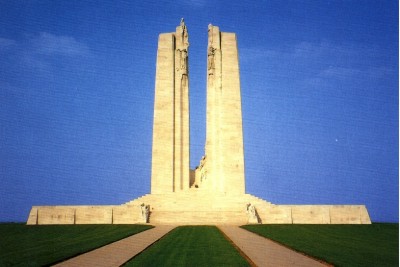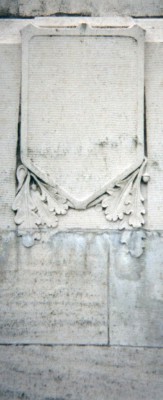The Vimy Memorial

(This image scanned from a Vimy Memorial postcard)
Vimy Memorial park is nearly all forested now. In 1917 it would have been denuded of trees, and precious few blades of grass would have been seen. Reforested to minimize the effects of erosion, the ground is now carpeted by a rich blanket of thick green grass. Most sections of the park are out-of-bounds to visitors and one glance, to the initiated, shows why. Other than the reforestation, the ground has not been altered since the battle. Every inch of the park still retains the shape of each shell-hole and collapsed trench-line, to the extent where no level spot can be seen on either side of the roads. This preservation extends into the fields around the monument except where they needed space to support the construction.
I have walked impact areas on Canadian bases which have seen forty or more years of artillery training, and even though Gunner's eyes are invariably attracted to the same targets, I have never seen an area as shattered and reshaped by high explosive as the fields around the Vimy Memorial. It is hard to imagine walking easily across them now, with a grassy surface, good footwear and no heavy pack. To consider what strength, physical and psychological, that it would have taken an infantry soldier of 1917 to cross that terrain is barely conceivable. And then to imagine four men bearing a stretcher loaded with one of their mates over it is even more incredible.
But the grounds are not restricted just because of their treacherous footing. It is estimated that there is one piece of unexploded munition in those woods for every square metre of ground. With that in mind, one understands why the grass-cutting in most of the park is executed by herds of sheep.
We walk slowly along the roads from the restored trenches to the Monument itself. Again, we are taken by the impact of its simple design as seen from a distance. This marks the highlight of the trip for many, for few Canadian soldiers have not read of the battle of Vimy Ridge and of the Monument itself. But to stand upon its stones is a very great thing that cannot be adequately described with mere words.
First we walked around the main pylons of the monument on its limestone base. At the foot of the solitary erect statue on the main wall of the base, a female figure representing Canada Mourning, we lay our wreath and observed a few minutes silence for the soldiers who fell fighting for this ground.
Quietly, in ones and twos, we spread out to see the many impressive details of the monument. I will not attempt to describe every aspect of the site, as I could not do it justice and some aspects such as the visages of the statues are well conveyed in available photographs. In general, the statuary represents the great loss and grief of war, this is not a monument to glorify conflict, rather it serves as a solemn reminder of the terrible things mankind has wrought upon his brother.
On the two pylons, in French and English, is the inscription: "To the valour of their countrymen in the Great War and in memory of their sixty thousand dead this monument is raised by the people of Canada."
Around the base of the Monument are inscribed 11,825 names of Canadian soldiers who died in the First World War and have no known graves. Walking along these walls of names is utterly overwhelming, seeing each soldier so remembered for all time, his sacrifice not forgotten as long as the people of Canada visit this place and maintain this stone work of art. The Vimy memorial is stained and shows its age. The surface, surprisingly to me, is not the smooth surface of dressed stone, but is rough in texture, deliberately prepared to be so. In retrospect this coarse finish on the stone is probably more fitting to the somber purpose of the Monument. Any Canadian that travels to Europe should visit Vimy Ridge. They should walk these grounds and quietly thank those who sacrificed themselves in the first of two great wars of the Twentieth Century to defend and maintain the principles and tenets of western society. No photo or collection of words, no matter how nicely narrated, can replicate the power, the intensity and the impact of standing on Hill 145 and trying to visualize what powers and what love for their fellow man it must take to make men willing to achieve such a feat of arms.
Lest We Forget.
Michael O'Leary

In 1936, Canadian Legion of the British Empire Service League organized a Pilgrimage to the dedication of the Vimy Memorial and the Battlefields. The pilgrimage took place in July-August 1936. A Guidebook provided to the "pilgrims" included a maps and the order of battle charts for the Canadian Corps at Vimy Ridge, these are reproduced at the following links:
- The Assault at Vimy; The Canadian Corps Order of Battle
- The Assault at Vimy; Battlefield Maps
- The Assault at Vimy; Evolution of the Battle Order
Lest we Forget
Photos by Michael M. O'Leary (except where noted) - May 2000
- The O'Leary Collection; Medals of The Royal Canadian Regiment.
- Researching Canadian Soldiers of the First World War
- Researching The Royal Canadian Regiment
- The RCR in the First World War
- Badges of The RCR
- The Senior Subaltern
- The Minute Book (blog)
- Rogue Papers
- Tactical Primers
- The Regimental Library
- Battle Honours
- Perpetuation of the CEF
- A Miscellany
- Quotes
- The Frontenac Times
- Site Map
QUICK LINKS
Perpetuation
Auftragstaktik
The Regimental System
Section Attack; Part 1
Section Attack Part 2
Tiger's Can't Live in a Box
A la Bayonet
21st Century Infantry Company
Vimy Memorial
Dieppe Cemetery
Unknown Soldier
How to Suck an Egg
Too Few Honours; Rumours of Historical Parsimony in Regimental Honours and Awards
Battle Honours of The RCR




